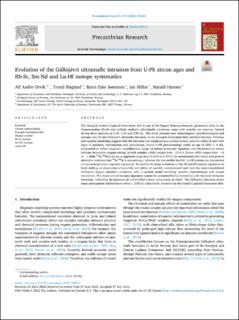| dc.contributor.author | Orvik, Alf Andre | |
| dc.contributor.author | Slagstad, Trond | |
| dc.contributor.author | Sørensen, Bjørn Eske | |
| dc.contributor.author | Millar, Ian | |
| dc.contributor.author | Hansen, Harald | |
| dc.date.accessioned | 2022-11-10T10:27:55Z | |
| dc.date.available | 2022-11-10T10:27:55Z | |
| dc.date.created | 2022-08-05T08:34:56Z | |
| dc.date.issued | 2022 | |
| dc.identifier.citation | Precambrian Research. 2022, 379 . | en_US |
| dc.identifier.issn | 0301-9268 | |
| dc.identifier.uri | https://hdl.handle.net/11250/3031117 | |
| dc.description.abstract | The Karasjok–Central Lapland Greenstone Belt is one of the largest Palaeoproterozoic greenstone belts in the Fennoscandian Shield and includes multiple (ultra)mafic intrusions, some with notable ore reserves, formed during three episodes at 2.44, 2.22 and 2.05 Ga. This study presents new mineralogical, geochronological and isotopic data for the Gállojávri ultramafic intrusion, in the Karasjok Greenstone Belt, northern Norway. Previous petrogenetic modelling suggests that the intrusion was emplaced as a conduit system open for influx of melt with signs of polybaric fractionation and assimilation. Zircon U-Pb geochronology yields an age of 2051 ± 8 Ma, interpreted to reflect magmatic crystallisation. Large variations in isotopic signature over decimetres to metres indicate incomplete magma mixing. In bulk samples, εNd(t) ranges from −15 to 4. Zircon εHf(t) ranges from −14 to −1. Bulk 87Sr/86Sr(t) shows an apparent range from 0.5041 to 0.7072: the anomalously low values and general alteration indicates that 87Sr/86Sr is non-primary, whereas the less mobile Sm-Nd/ Lu-Hf systems are interpreted to represent primary magmatic signatures. We ascribe the large variations in the Nd and Hf isotopic signatures to local melting or dissolution of xenoliths and influx of variably contaminated melt into the semi-consolidated Gállojávri magma chamber, consistent with a conduit model involving variable replenishment and crustal interaction. The most evolved isotopic signatures cannot be accounted for by interaction with the local Archaean basement, indicating the presence of unidentified crustal components at depth. The Gállojávri intrusion shows many petrogenetic similarities to other c. 2.05 Ga (ultra)mafic intrusions in the Central Lapland Greenstone Belt. | en_US |
| dc.language.iso | eng | en_US |
| dc.publisher | Elsevier | en_US |
| dc.rights | Navngivelse 4.0 Internasjonal | * |
| dc.rights.uri | http://creativecommons.org/licenses/by/4.0/deed.no | * |
| dc.title | Evolution of the Gállojávri ultramafic intrusion from U-Pb zircon ages and Rb-Sr, Sm-Nd and Lu-Hf isotope systematics | en_US |
| dc.title.alternative | Evolution of the Gállojávri ultramafic intrusion from U-Pb zircon ages and Rb-Sr, Sm-Nd and Lu-Hf isotope systematics | en_US |
| dc.type | Peer reviewed | en_US |
| dc.type | Journal article | en_US |
| dc.description.version | publishedVersion | en_US |
| dc.source.pagenumber | 16 | en_US |
| dc.source.volume | 379 | en_US |
| dc.source.journal | Precambrian Research | en_US |
| dc.identifier.doi | https://doi.org/10.1016/j.precamres.2022.106813 | |
| dc.identifier.cristin | 2041316 | |
| cristin.ispublished | true | |
| cristin.fulltext | original | |
| cristin.qualitycode | 2 | |

